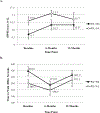Effects of Changes in Regional Body Composition on Physical Function in Older Adults: A Pilot Randomized Controlled Trial
- PMID: 26482693
- PMCID: PMC8889927
- DOI: 10.1007/s12603-015-0523-y
Effects of Changes in Regional Body Composition on Physical Function in Older Adults: A Pilot Randomized Controlled Trial
Abstract
Background/objective: Obesity exacerbates age-related physical disability; however, observational studies show that any weight loss in old age is associated with greater risk of mortality. Conversely, randomized controlled trials in older adults show that weight loss is beneficial. The discrepancy may be due to weight loss intention and differential changes to regional body composition. The purpose of this research was to evaluate the independent role of regional body composition remodeling in improving physical function.
Design: Pilot Randomized Controlled Trial.
Setting: Community based research center.
Participants: Thirty-six community dwelling, overweight to moderately obese (BMI 28.0-39.9 kg/m2) older adults (age 70.6±6.1 yrs).
Intervention: Physical activity plus weight loss (PA+WL, n=21) or PA plus successful aging (SA) education. PA consisted primary of treadmill walking supplemented with lower extremity resistance and balance training. The WL program was based on the Diabetes Prevention Project and aimed at achieving a 7% weight loss by cutting calories, specifically those from fat.
Measurements: At baseline, 6- and 12-months, body composition was measured using computerized tomography and dual x-ray absorptiometry. Abdominal visceral (VAT) and thigh intermuscular (IMAT) adipose tissue were quantified. Physical function was assessed using the short physical performance battery (SPPB).
Results: Separate multivariable linear regression models with both groups combined demonstrated that decreases in IMAT and VAT were significantly associated with improvements in SPPB (P<0.05) independent of change in total fat mass. PA+WL improved SPPB scores from baseline (0.8±1.4, P<0.05), whereas PA+SA did not; however no intergroup difference was detected. Of note, these effects were mainly achieved during the intensive intervention phase.
Conclusion: Decreases in IMAT and VAT are important mechanisms underlying improved function following intentional weight loss plus physical activity.
Trial registration: ClinicalTrials.gov NCT00714506.
Conflict of interest statement
Figures



Similar articles
-
Effect of an 18-month physical activity and weight loss intervention on body composition in overweight and obese older adults.Obesity (Silver Spring). 2014 Feb;22(2):325-31. doi: 10.1002/oby.20607. Epub 2013 Sep 20. Obesity (Silver Spring). 2014. PMID: 23963786 Free PMC article. Clinical Trial.
-
Fat mass loss predicts gain in physical function with intentional weight loss in older adults.J Gerontol A Biol Sci Med Sci. 2013 Jan;68(1):80-6. doi: 10.1093/gerona/gls092. Epub 2012 Apr 13. J Gerontol A Biol Sci Med Sci. 2013. PMID: 22503993 Free PMC article. Clinical Trial.
-
The effect of pioglitazone and resistance training on body composition in older men and women undergoing hypocaloric weight loss.Obesity (Silver Spring). 2011 Aug;19(8):1636-46. doi: 10.1038/oby.2010.327. Epub 2011 Jan 13. Obesity (Silver Spring). 2011. PMID: 21233810 Free PMC article. Clinical Trial.
-
Visceral adiposity and inflammatory bowel disease.Int J Colorectal Dis. 2021 Nov;36(11):2305-2319. doi: 10.1007/s00384-021-03968-w. Epub 2021 Jun 9. Int J Colorectal Dis. 2021. PMID: 34104989 Review.
-
Exercise Training to Decrease Ectopic Intermuscular Adipose Tissue in Individuals With Chronic Diseases: A Systematic Review and Meta-Analysis.Phys Ther. 2021 Oct 1;101(10):pzab162. doi: 10.1093/ptj/pzab162. Phys Ther. 2021. PMID: 34174085
Cited by
-
Intramuscular Fat Accumulation and Associations With Body Composition, Strength, and Physical Functioning in Patients With Rheumatoid Arthritis.Arthritis Care Res (Hoboken). 2018 Dec;70(12):1727-1734. doi: 10.1002/acr.23550. Epub 2018 Nov 2. Arthritis Care Res (Hoboken). 2018. PMID: 29481721 Free PMC article.
-
Anti-Inflammatory Strategies Targeting Metaflammation in Type 2 Diabetes.Molecules. 2020 May 9;25(9):2224. doi: 10.3390/molecules25092224. Molecules. 2020. PMID: 32397353 Free PMC article. Review.
-
Validation of a description of sarcopenic obesity defined as excess adiposity and low lean mass relative to adiposity.J Cachexia Sarcopenia Muscle. 2020 Dec;11(6):1580-1589. doi: 10.1002/jcsm.12613. Epub 2020 Sep 15. J Cachexia Sarcopenia Muscle. 2020. PMID: 32931633 Free PMC article.
-
Intermuscular adipose tissue in metabolic disease.Nat Rev Endocrinol. 2023 May;19(5):285-298. doi: 10.1038/s41574-022-00784-2. Epub 2022 Dec 23. Nat Rev Endocrinol. 2023. PMID: 36564490 Review.
-
Practice of physical activity and dysmobility syndrome in community-dwelling older adults.J Exerc Rehabil. 2019 Apr 26;15(2):294-301. doi: 10.12965/jer.1938034.017. eCollection 2019 Apr. J Exerc Rehabil. 2019. PMID: 31111016 Free PMC article.
References
-
- Villareal DT, Apovian CM, Kushner RF, Klein S (2005) Obesity in older adults: technical review and position statement of the American Society for Nutrition and NAASO, The Obesity Society. Am J Clin Nutr 82:923–934. - PubMed

